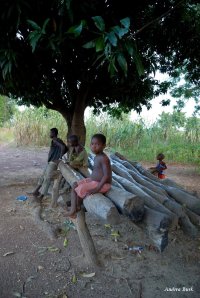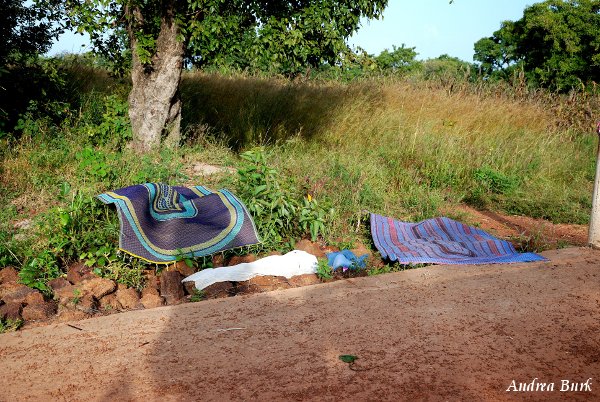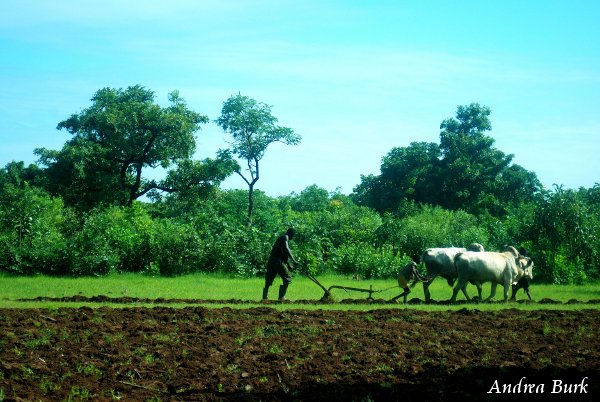Monthly Archives: October 2011
Let’s Redefine “Poor”
As I said in the About Me section, the point of my photos and blog is to call attention to people who need help in some way. The country of Burkina Faso is one of the top ten poorest countries in the world, with the rural Dagara being on the lower end of the the spectrum of poverty. Instead of falling into the temptation of shaking our heads sadly and then mostly ignoring it, I would like to challenge all of us to start to confront the general issue of poverty by looking at the specific poverty of the Dagara.
What images or ideas come to your mind when you think of a poor person? Do you think of someone in your own country who lives in a run down house and doesn’t have the same things you have? Do you think more globally, yet abstractly with the images of National Geographic and Ethiopia engrained on your mind? What are your emotional reactions and thought processes?
It’s not uncommon to read or hear a comment such as “Why are we sending money off to some foreign country to help the poor? We have poor people of our own we should be helping!” We will then often hear another “side” to the coin which sounds somewhat judgmental toward the poor themselves, insinuating that they have enough but just don’t know how to budget or manage their money. Let’s remember that it’s not helpful to anyone in this difficult situation to be judgmental on either side of the issue. Although poverty is definitely relative to the country and culture in which it exists, I believe we need to also step back and redefine what poverty actually looks like.
There are all kinds of poverty in this world: physical, spiritual, mental, etc. Many times the poverty that comes to our minds and seems more prevalent in the U.S. involves more of the mental attitudes that come with physical poverty. Although there are impoverished attitudes in Burkina, the poverty that strikes someone visiting here is overwhelmingly physical. Our team recently had some visitors who were quite taken aback by the poverty here. They made the comment that seeing it in person is a completely different experience from the two-dimensional photos and articles they might see back in the safety of their own home and environment.
 As a starting point of comparison, this graph of the amenities owned by people classified as poor in the U.S. says that a family of four is poor if they earn around 22,000 dollars or less per year. This is more money than the majority of the Burkinabe could ever dream of seeing. The average worker in Burkina earns only about 2 dollars a day. According to this chart, almost all of the poor in the U.S. own a refrigerator, television, stove and oven, which most Americans would definitely consider the basics. These are followed by microwaves, air conditioning, and VCRs and DVD players. After this begins the “extras” of more than one or two televisions, cordless phones, washers and dryers, and stereos. These things are available in Burkina, but only in the towns and cities. The basis for most of these appliances, electricity, is not out to the villages yet.
As a starting point of comparison, this graph of the amenities owned by people classified as poor in the U.S. says that a family of four is poor if they earn around 22,000 dollars or less per year. This is more money than the majority of the Burkinabe could ever dream of seeing. The average worker in Burkina earns only about 2 dollars a day. According to this chart, almost all of the poor in the U.S. own a refrigerator, television, stove and oven, which most Americans would definitely consider the basics. These are followed by microwaves, air conditioning, and VCRs and DVD players. After this begins the “extras” of more than one or two televisions, cordless phones, washers and dryers, and stereos. These things are available in Burkina, but only in the towns and cities. The basis for most of these appliances, electricity, is not out to the villages yet.
In villages, as opposed to towns and cities, living conditions can be harsh. Since there is no electricity, all the amenities available in the Western world and in the cities are completely irrelevant to their lives. Instead of a washing machine, women wash their clothes in the nearest body of water, often having to do so without soap to really get them clean. Instead of flipping on a light switch, they have oil burning lamps. If they are broken or out of fuel, people will have to go without until they can save money and make it to the next weekly market. The market could be near or far, depending on what they need to buy, and most people will have to go on foot. Many times you can see an elderly woman who has just walked a long distance with her shoes on her head in order to help them last longer. In the remote villages, fewer people have bicycles and even fewer have motorcycles.
As far as attitudes go, in Burkina, a person can work really hard all day long and still not get anything to eat that day, or possibly only one meal. This can happen for a variety of reasons, one of which is that they are in the middle of the hunger months mentioned in the last post, and are trying to make their food last as long as possible. It’s not uncommon for a person to go an entire week without eating. There are also those who feel defeated by poverty, or just don’t think that there is a way to lift themselves out of it. However, most are just working as hard as they can.

The interior of a village home taken with the natural light coming from the doorway. Notice the roof made of wood.

A wonderful "couch" of logs in the courtyard. They sometimes sleep here as well when it's too hot to sleep inside.
The interior of a village home functions more as just a place to store things and sleep than as a place to hang out doing leisure activities. Most of their lives are spent outside, so their chairs and other places to sit are in their courtyards. When they do go to sleep at night, it’s not usually on a bed, but on a mat on the packed down, hard earth floor. Some mats are very thin, woven from plastic, while others are made out of a type of hollow reed or straw. Sometimes they will have a wooden bed frame with a straw or foam mattress, but also many times they may have nothing but flattened cardboard boxes.

Another kind of sleeping mat made out of straw. They roll them and hang them up during the day to keep them clean. The smaller bundles attached in front are brooms.
Despite all the difficulties, people are just living their lives. They have times of happiness and celebration as well as sadness and mourning. They work to make their food or earn a little money. They play soccer or children play marbles or other made up games. They accept life the way it is, yet for the most part, don’t give up.
What do you think? This really only scratches the surface of this issue. In future posts we will discuss how this affects the education and medical systems. I would love to get a dialogue going. Has this changed your perspective on poverty? Do you know any poor people near you? Have you seen good things being done to alleviate poverty? What do you think can be done to encourage those in poverty to think positively about changing their situation? I’d love to hear any thoughts you have on this!
Painting the background
Daily life among the Dagara, or any people group in Burkina Faso, is full of activities geared toward survival. Life is hard: the terrain and climate are unforgiving; resources are scarce or non-existent; and the mindset of generational poverty limits what the average person even dreams he can accomplish. Yet the people are full of life, love, friendship, and joy. In the articles to follow, I will be going into more detail about the various aspects of the culture with the goal of spreading understanding and compassion.
In order to truly understand the people, it’s important to paint the background picture, which in this case is the terrain and climate of Burkina Faso. Although rather small (about the size of Colorado), Burkina has some variance in climate from more tropical in the south to the borders of the Sahara in the north, called the Sahel. In this semi-arid tropical environment, there are only two seasons: rainy and dry. The rainy season lasts from about May to September in Dagara-land, with the transition months of May and October being particularly humid and uncomfortably hot. During the dry season, the Harmattan winds come down from the deserts in northern Africa, bringing with them so much dust that the air is full of it and even partially blocks the sun. Because of this, temperatures can be cooler during the months of December to February, yet are gradually heating up to the hottest time of the year in April.

The dry season terrain. Notice the hazy, dusty sky.

A similar view at the end of rainy season. Notice the same big house in the background and the peanut crop in the foreground. The grasses and weeds have grown so high they conceal small buildings.
If you’ve ever been in West Texas on the hottest summer day imaginable, then you’re on your way to understanding the heat here. However, imagine that you don’t have access to any air conditioning and that you don’t have the comforting thought that fall and winter are coming. Also, most of your daily life is lived outdoors, dependent on the weather and the ground for your food. We all know how the weather can affect us. Yet, while we have people and technology predicting the next week for us so that we can plan our activities accordingly, the average person living in a village must exist in a somewhat flexible state of unpredictability.
This weather pattern has other effects on the daily life of the people as well. During the relatively cool and dusty dry season, people are actually wearing winter coats and hats and tend to get “winter colds” as well as other contagious diseases, such as meningitis, which are at a peak because of germs being transferred on the dust. When riding in our truck with the sun somewhat obscured, the air conditioner going, and people walking along the side of the road all bundled up, we can pretend it’s just a “hazy shade of winter.”
During the hotter times, we as foreigners may think that the Burkinabe are used to the heat, but they are affected by it just as much as we are. It’s just not possible to get a lot done when the temperature is oppressively hot. Because of this, there is a tradition here of getting up early in the cooler hours of the morning to get some work done, and then taking a sieste, or rest time, in the middle of the afternoon. This is changing somewhat and is not always observed, but most businesses still follow this pattern. This definitely dictates a slower pace of life for the whole country.
And yet, the dry, hot season has its activities as well. The main food harvest of corn, millet, and peanuts has already taken place around October, and planting on a large scale cannot take place yet since nothing will grow without rain. Although there may seem to be a lot of idle time, cotton is harvested in December and dry season is a great time to build so the walls will have plenty of time to harden. Because people have some extra time that is not needed for the fields, this is also a great time for evangelism and literacy classes.

Mud brick walls with mud mortar are typically covered by a thin coating of concrete or a manure and mud mixture.

During rainy season everything is in bloom or green. Colors look particularly vibrant against a stormy sky.
Typically, May is when the rains begin to come. People start clearing their fields and preparing the soil. The rain softens the soil that has been baking in the hot sun, so as soon as it rains, they drop other plans and go out to the fields to work. Plowing and planting continue throughout June as the rains come more often. In July, as the terrain is looking very lush, people are actually nearing the end of their food supply. Granaries are emptying and there are only certain vegetables available. Prices tend to go up as food is at a premium. The Dagara call this time period the “hunger months.”
Water is more plentiful, but can also be an enemy when it rains so much that their mud brick houses fall down. It seems that every year a few people lose their lives in the night because a wall falls on them in their sleep. Some people even continue to live in these houses because there is no other place to go. It varies as to how soon they can get it repaired.
With the rainy weather comes cooler temperatures, at least while it’s raining. Between rain showers it can get quite humid. However, in July and August there are days that are completely rainy and very pleasant.
Working in the fields is a family affair as most is done by backbreaking personal labor using a hoe called a “daba.” It is short and requires that the user bend over to work. Some people might have plows pulled by oxen, or are able to rent them, but the majority rely on having large families.
All of this has shaped the habits and thinking of the Burkinabe. Because they are at the mercy of the weather and have to rely on each other for survival, they have a tendency to emphasize events over time and people over tasks.
This has profound implications for the economy and other aspects of Burkina life. Instead of having the expectation of working the set hours of 8-5, for example, the people have developed a more laid-back attitude. Although this can be a little difficult to get used to for the Western mindset which wants to have a task list of things to accomplish everyday, it is also a welcome change of pace. It is nice to be able to spend hours just sitting and chatting with a friend, developing a meaningful relationship, in part because you have given your time.
Who you know and showing respect to those in authority also become very important in a people-centered society. Living in close relationships with others is vital. Families are so closely tied as a group that if one person starts to become successful, many others will put pressure on them to lift them up socially or economically as well. There is more emphasis on the community than on the individual, which can make it difficult to change one’s situation; however, the good side of this is that most people also have others they can rely on in times of trouble.
What do you think? It’s not often that we who are more used to the conveniences of the “first world” even think about how the weather affects our society, other than to be irritated at the “bad” weather or grateful for rain after a drought. What effects have you noticed the climate having in your area? Does it affect your daily life or are you able to keep a fairly regular schedule anyway?





















